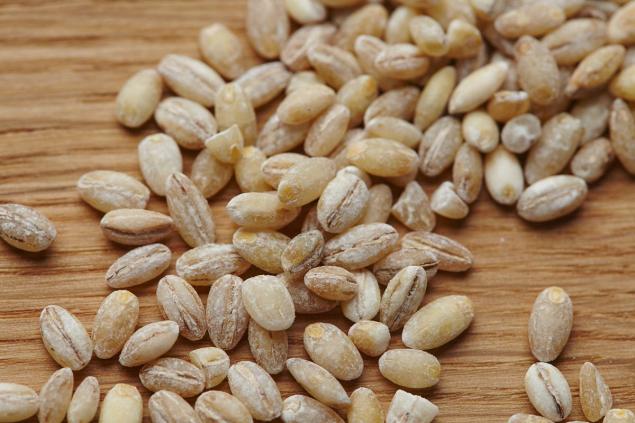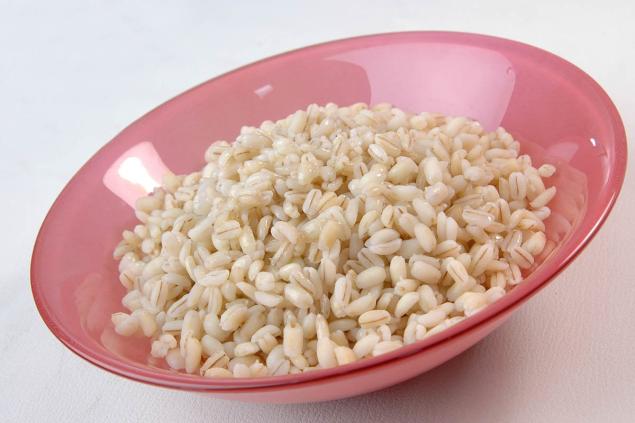186
Why cook barley and potatoes in one pan and what will come out of it, my husband was delighted.
To the question, How much barley is brewedThe hostess responds differently. The cooking time of this cereal ranges from 30 minutes to 1 hour. Dishes from barley are delicious and useful, but quickly cook cereals will not work. If you want to cook porridge in a couple of minutes, cook small barley cereals.

Some housewives do not like to cook porridge from pearl cereals for the reason that they have to give it a long heat treatment. Not everyone knows that the time how much barley is cooked directly depends on the duration of its pre-soaking.
If you pour barley water and leave it overnight, the porridge will be cooked in half an hour. And without a long soak it will have to languish for about an hour. The time of cooking cereals is regulated depending on the consistency of the dish that needs to be prepared.

For example, the preparation of ordinary pearl porridge will take from 30 to 45 minutes. Fans of barley like it when the dish turns crumbly. For this purpose, the cereal is thoroughly washed, soaked, and then cooked on a slow fire. Some housewives advise to change the water a couple of times during cooking, so that the grains do not stick together at all and are elastic.
If you decide to cook a dish of Estonian cuisine - mulgipuder, then be ready to hold barley on the stove for at least 60 minutes: the cereal should completely soften and form a homogeneous puree with potatoes. This dish is a prime example of what Estonian food looks like: simple and nutritious.

In Estonia, they prefer to cook simple and hearty, so they use different cereals for food. But the most popular barley there: it is added to potatoes, cabbage and put in blood sausage. There are no exquisite dishes among Estonian recipes, since their food is more like a rural menu: cereals, soups, fish and pork.
Baltic dishes are difficult to surprise, but really feed to the dump. We saw this when our aunt came to visit us. She has been living in Estonia for a long time, so her tastes have changed a little bit from ours. My aunt was asked to cook something from her daily menu. Svetlana agreed and started cooking mulgipuder.
All observers were very surprised when the woman poured a glass of barley on a clean pan and began to roast it to a slightly golden color. Then she poured cereal into the Kazan and poured a liter of water there.
777844
When the porridge boiled, Svetlana lowered the fire and covered the Kazan with a lid. Meanwhile, the hostess washed and peeled a kilogram of potatoes and then cut them into pieces. When the cereal was almost ready, the aunt threw potatoes into the Kazan, mixed everything, filled a glass of water and salted. Perlovka languished along with the potatoes.
And Svetlana asked me to give her a small piece of bacon. She cut the pork and started roasting. Then she added two crushed bulbs to the bacon. When the onion was well fried, our guest salted it and added some pepper.

Removing the pan from the fire, Svetlana checked the readiness of the potatoes. Making sure that he cooked, the aunt began to knead potatoes with a pestle. She then added a couple of spoonfuls of skins in the mashed potato and stirred. All this time we watched the hostess with interest, hoping to see something unusual. But no miracle happened. The cook announced that lunch was ready.
The puree was laid out on plates, generously tucked in roasted bacon, and salted cucumbers and sauerkraut tomatoes were put on the table. We liked the food, but we all wanted to add more spices.

Our conclusion: Estonian dishes are good for every day, but guests will not be surprised by them on the festive table.

Some housewives do not like to cook porridge from pearl cereals for the reason that they have to give it a long heat treatment. Not everyone knows that the time how much barley is cooked directly depends on the duration of its pre-soaking.
If you pour barley water and leave it overnight, the porridge will be cooked in half an hour. And without a long soak it will have to languish for about an hour. The time of cooking cereals is regulated depending on the consistency of the dish that needs to be prepared.

For example, the preparation of ordinary pearl porridge will take from 30 to 45 minutes. Fans of barley like it when the dish turns crumbly. For this purpose, the cereal is thoroughly washed, soaked, and then cooked on a slow fire. Some housewives advise to change the water a couple of times during cooking, so that the grains do not stick together at all and are elastic.
If you decide to cook a dish of Estonian cuisine - mulgipuder, then be ready to hold barley on the stove for at least 60 minutes: the cereal should completely soften and form a homogeneous puree with potatoes. This dish is a prime example of what Estonian food looks like: simple and nutritious.

In Estonia, they prefer to cook simple and hearty, so they use different cereals for food. But the most popular barley there: it is added to potatoes, cabbage and put in blood sausage. There are no exquisite dishes among Estonian recipes, since their food is more like a rural menu: cereals, soups, fish and pork.
Baltic dishes are difficult to surprise, but really feed to the dump. We saw this when our aunt came to visit us. She has been living in Estonia for a long time, so her tastes have changed a little bit from ours. My aunt was asked to cook something from her daily menu. Svetlana agreed and started cooking mulgipuder.
All observers were very surprised when the woman poured a glass of barley on a clean pan and began to roast it to a slightly golden color. Then she poured cereal into the Kazan and poured a liter of water there.
777844
When the porridge boiled, Svetlana lowered the fire and covered the Kazan with a lid. Meanwhile, the hostess washed and peeled a kilogram of potatoes and then cut them into pieces. When the cereal was almost ready, the aunt threw potatoes into the Kazan, mixed everything, filled a glass of water and salted. Perlovka languished along with the potatoes.
And Svetlana asked me to give her a small piece of bacon. She cut the pork and started roasting. Then she added two crushed bulbs to the bacon. When the onion was well fried, our guest salted it and added some pepper.

Removing the pan from the fire, Svetlana checked the readiness of the potatoes. Making sure that he cooked, the aunt began to knead potatoes with a pestle. She then added a couple of spoonfuls of skins in the mashed potato and stirred. All this time we watched the hostess with interest, hoping to see something unusual. But no miracle happened. The cook announced that lunch was ready.
The puree was laid out on plates, generously tucked in roasted bacon, and salted cucumbers and sauerkraut tomatoes were put on the table. We liked the food, but we all wanted to add more spices.

Our conclusion: Estonian dishes are good for every day, but guests will not be surprised by them on the festive table.
Why actress Verico Anjaparidze became a legend during her lifetime and how her memory is kept in Georgia
Stella looked into the future and told who will be the next president of Ukraine























